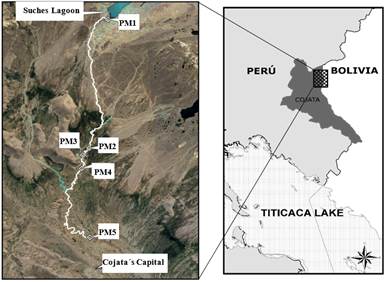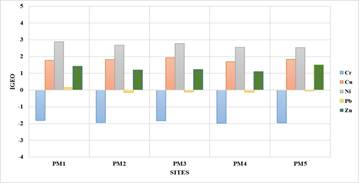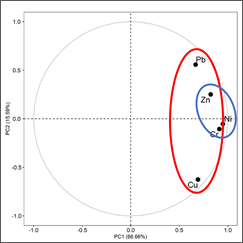INTRODUCTION
Small-scale mining significantly influences the development of the economy of high Andean regions1. However, due to the use of semi-mechanized technology, an inadequate management of the residuals frequently occurs. This causes the overflow of tailing ponds or the collapse of sedimentation ponds2),(3, and represents a high risk of environmental contamination. Consequently, the quality of different environmental components is affected due to the increase of potentially toxic substances to the aquatic and terrestrial life4.
The artisanal gold mining projects and their operations are producing considerable alterations in the composition and structure of the organisms that live in the river courses and their banks. Thus, there is an increasing risk of exposure to contaminating substances to the surrounding populations that live in areas mainly intended for agricultural activities5.
The artisanal processes of extraction of alluvial gold generates the increase of the weathering of the primary rock, and alter the quality of the sediments transported through the rivers. These rivers are channeled by the geomorphology of the basin and the presence of the minerals silt-clay-clay6. Similarly, for the evaluation of the quality of sediments, these are compared with the limit values assigned by national and international standards or with reference to regional data. These data provide indication about the state of the environmental component.
Complementing sediment evaluations with multivariate statistical techniques is beneficial since it allows a deeper analysis of the quality of these particles in rivers7. It also allows to identify and obtain more information on the predominant sources of contamination. The use of these findings would encourage the creation of management actions aligned with environmental quality standards. In addition, it would encourage the creation of baselines for the implementation of management and conservation plans, and the evaluation of the state of ecological risks produced by metals in sediments8.
The statistical analysis explores the forms of association of the variables, and defines the correlation between them9),(10, with the main objective being, to cover as many variations as possible from the collected data. This allows reducing the original data without losing significant information and generating new variables called principal components11. These components will be used to determine the groupings of the original variables with approximately the same pattern.
The objectives of this research are to determine the concentration of heavy metals in superficial sediments of the Suches River; and to evaluate the pollution through environmental norms, geochemical indexes and technical multivariate statistics.
EXPERIMENTAL
Study Area
The Suches River has a length of 164 km12 and is one of the most important tributaries in the region of Puno, Peru. This is because it drains its waters to Lake Titicaca and it constitutes a natural border with Bolivia (Figure 1). This river is part of the Suches basin, where there are important concentrations of gold, and open-pit mining works are carried out. However, in recent years, there have been health problems in nearby towns affecting the local economy because cattle have died from metal poisoning due to the informal mining that takes place in the area13.
Collection, determination and evaluation of sediment samples with heavy metals
Following the criteria from the National Protocol for Monitoring Water Resources14, 250g of superficial sediment (0-5 cm) was collected from five sites of the Suches River (Table 1) during the transition from dry season (October to December) and the rainy season (January and February). Later, the samples were stored in hermetic bags and stored at a temperature of 4 °C until they were analyzed in the laboratory. The concentrations (mg kg-1) of five metals Cr, Cu, Ni, Pb and Zn were determined by ICP-MS in the laboratories accredited by ALS Corplab (branch in Arequipa). In order to identify the metals from the natural resources, the geochemical index by erosion aluminum - titanium (Al/Ti) was used, considering Aluminum (Al) and Titanium (Ti) as lithogenic elements. These, according to Duzgoren - Aydin et al.15, are elements that do not show substantial changes by the process of sedimentary rock formation. Finally, the concentration of heavy metals was evaluated with the Canadian Sediment Quality Guidelines to assess if the values exceed international regulations16.
Estimation of the contamination of sediments
According to Tukerian and Wedepohl17, the background values (Cr=35; Cu=2; Ni=2; Pb=7; Zn=16) used to evaluate the contamination of sediments by metals were based on the type of sandstone rock predominant in the area of study18. The geo-accumulation index (Igeo) was calculated with the following Eq.1.
Where, Ci metal is the concentration of the metal studied, Ci metal is the background value of the metal, and 1.5 is the background factor correction for the sedimentary, petrological characterization, and other influences. According to the geo-accumulation index, the sediments may be classified in the following: Class 0 or unpolluted (Igeo<0); Class 1, unpolluted to moderately polluted (0≤ Igeo< 1); Class 2, moderately polluted (1≤Igeo<2); Class 3, moderately to heavily polluted (2≤Igeo<3); Class 4, Heavily polluted (3≤Igeo<4); Class 5, heavily to extremely polluted (4≤Igeo<5); and Class 6, Extremely polluted (Igeo≥5).
Relationship between variable and factor analysis
To determine the degree of dependence between two or more heavy metals, the normality of metal concentrations in sediments was verified with the Shapiro-Wilk test. Subsequently, the analysis of Spearman's correlation coefficient was applied, whose value was found between the range ±1. The coefficients obtained were classified as follows: greater than 0.75 has a strong association; 0.50 to 0.75, a moderate association, and finally, from 0.30 to 0.50 indicates that there is a weak dependence19. Finally, principal component analysis (PCA) was used to determine the possible sources of the metals, as well as to find groups within the data. For this, the concentrations obtained was determined by using the Kaiser-Meyer-Olkin (KMO) test, which evaluates the adequacy of the data to carry out the PCA and classifies them as follows: if KMO < 0.5, it is unacceptable to apply the PCA; if KMO is between 0.5 and 0.7 it is moderately acceptable and if KMO > 0.7 it is acceptable to apply PCA. A second Bartlett sphericity test was also applied, which confirms whether it is appropriate to apply PCA, when the p-value is below 0.05. Subsequently, the data were standardized and PCA analysis was carried out using the normalized varimax rotation with which the components due to the accumulated variance greater than 70% and/or the eigenvalue greater than 120 can be identified. Data analysis was performed using R software version 4.0.221.
RESULTS
Concentration and evaluation of heavy metals in sediments
Table 2 shows the average concentrations of all points of heavy metals, in descending order Zn ˃ Ni ˃ Cr ˃ Cu ˃ Pb. These values were found below the Occasional Probable Effects (ISQG) level of the Canada Sediment Quality Standard (CEQG). However, the highest values of Zn, Ni and Cr are presented in PM1, which is close to the Suches lagoon and the open-pit mining area on the Peruvian side. The Pb presented its highest concentrations in PM2, which is located downstream of the Bolivian mining discharges. The Cu presented its highest concentrations in PM3 which is located close to agricultural activity.
Table 2 Statistical distribution of concentrations (mg/kg) of Cr, Cu, Ni, Pb, Zn in sediments from all sampling points of the Suches river
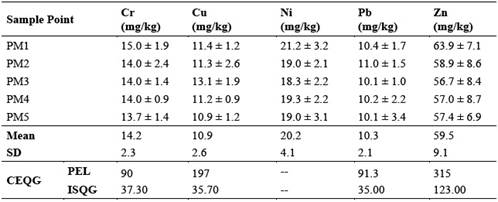
Table 3 presents a comparison of the concentrations of heavy metals found in this study with data from other studies carried out in rivers with mining influence to provide an overview of the state of pollution in relation to other tributaries. The studies showed the negative effects of heavy metal pollution on their ecosystems despite being classified as uncontaminated tributaries. The average of all metals by river in descending form is Zijiang > Tchangue > Xiazhuang > Suches > Changjiang.
Estimation of contamination in sediments
The geo-accumulation index (Figure 3) reveals that in all the sampling sites Cr belongs to class 0 (unpolluted); Pb falls under Class 1 (unpolluted to moderately polluted). In site PM1 and for all the other sites, it is in Class 0. Cu and Zn fall under class 2 in all the sampling sites suggesting that there is moderate pollution. On the other hand, Ni is in class 3 in all the sites which indicates that there is moderate to heavy pollution.
Relationship between variables
The concentration values are not present with normality. Figure 4 shows the correlation coefficient where Ni has a strong association with Cr and Zn (r>0.75 - 0.87; p<0.01). The relationship Al/Ti presents a moderate association with Cr, Ni and Zn (r>0.53 - 0.62; p<0.01-0.05).
Factorial Analysis
The KMO value was 0.8, which indicated that it was appropriate to apply the PCA and this was confirmed by applying Bartlett's sphericity test (p-value = 2.2 e-16 ˂0.01). Two principal components were revealed, since they presented 82.25% of the accumulated variance. PC1 represents 66.66% of the total variance, presenting strong positive charges with coefficients greater than 0.75 with the metals Cr, Ni and Zn. It also presents moderate charges (>0.50) with Cu and Pb. PC2 represents 15.59% of the total variance and presents moderate loads with coefficients greater than 0.50 with the metals Cu and Pb.
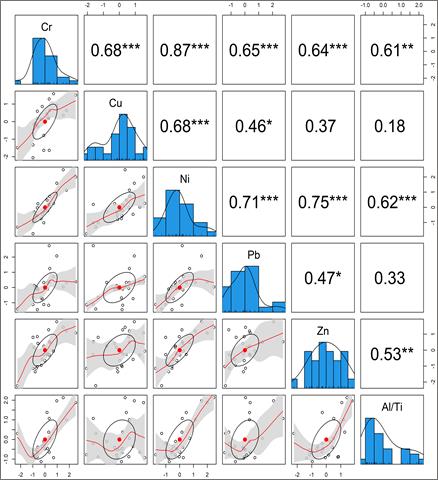
Figure 4 Correlation coefficients between heavy metals: *indicates p <0.10. **indicates p < 0.05. ***indicates p < 0.01. >0.75 has a strong association; 0.50 to 0.75 has moderate association; 0.30 to 0.50 weak dependence.
Figure 5 shows the PCA loading plots of the variables and the formation of the subgroups of the metals evaluated.
DISCUSSION
The determination of heavy metals reveals that major concentrations of Zn, Ni and Cr could be the result of Zn being found naturally in the earth´s crust, since it is a micronutrient that benefits flora and fauna27. Moreover, Ni is an element found in all mineralogical phases of igneous, metamorphic and sedimentary rocks28. Cr and Ni concentrations are found in dry soils with low nutrient levels29, which could indicate that their presence is due to the formation of moraines in the glacial areas of the Andes. Chromium is an essential element for superior organisms if it is found in trace amounts; however, in high concentrations, it is considered a toxic element29.
The results of this study were compared with other studies in which they were presented with nearby anthropogenic activities such as mining and agriculture, where they suggest that Pb comes from mining discharges, Cu from agriculture and finally Cr, Ni and Zn come from natural sources. Based on this and with our correlational and multivariate statistical results we affirm that the sources for our area of study are similar. The Pb has the highest concentration in PM2. This could be due to the existence of Bolivian mining settlements, which are artisanal and informal, which would suggest that industrial and domestic waste would be entering the study river. Copper increased its concentrations in the area of agriculture. This could be due to the fact that the development of this activity is mainly for livestock feed and the lack of copper sulfate forces farmers to spread this metal in their crops without an exact dosage. Finally, the three metals Cr, Ni and Zn would come from natural sources. Due to the rapid glacial retreat, sediment particles are released which form moraines, which after the removal of these soils for the recovery of gold could help the transport of these metals downstream. Metal mining, smelting and refining activities are recurrent in the areas surrounding the rivers evaluated. In addition, the presence of agricultural activity carried out by neighboring populations is common.
In the Zijiang and Tchangué rivers, the highest concentrations of heavy metals are reported during the rainy seasons, as the upper parts of their basins have abundant resources of non-ferrous metals and minerals associated with amphiboles, respectively. The Changjiang and Xiazhueng rivers exhibited lower metal concentrations, with Changjiang having rocky beds composed of marine sediments and Xiazhueng having acidic soils with vegetation.
On the other hand, the concentrations of heavy metals in this study would be below the ISQG and PEL levels provided by the Canadian sediment quality guideline22. Carrying out this type of evaluation alone would underestimate the identification of metals that generate different contamination classifications30, and would not include standard values for other elements of importance that are not included in the regulations5.
The Igeo revealed that Suches River is moderately polluted by Cu and Zn, which would suggest that there is an accumulation of these metals as a result of natural erosion and anthropogenic activities. This is probably from the artisanal mining activities in the area because minerals, such as chalcopyrite and galena, which are found naturally, are released due to soil removal31.
On the other hand, Ni presents a category of moderate to strong polluting level. This could be due to the presence of extensive and large moraine deposits that, according to Alloway29, are soils with low amounts of nutrients deposited progressively while receding the glacier. The transport of this metal downstream would be due to the construction of sedimentation ponds that usually overflow during the dry season32.
The simple correlation analysis reveals that Cr and Zn have a strong association which would indicate that they originate from natural weathering soil and from anthropogenic contributions from moraine deposits that were removed during the gold recovery process and the construction of sedimentary ponds.
Also, Cr and Zn present a moderate degree of association with the geochemical index of erosion (Al/Ti), which would confirm their natural and anthropogenic origin. Furthermore, Al/Ti also present a moderate association with Ni, confirming that this relationship is found in all types of soil and that their origin is mainly by erosion.
On the other hand, as revealed by the relationship between variables, the PCA suggests that the metals Cr, Ni and Zn are present in the lithology of the area because they present a positive charge (>0.75). It is inferred that the increase in the concentrations of these metals indicate that the PC1 component is of mixed origin.
The PC2 component has moderate loads (>0.50) of Cu and Pb metals; however, their association is opposite (Figure 4), which would reveal that they come from different anthropogenic sources. This is because according to the Igeo, Pb presents its highest value in the area near the mining settlements, and there may be a contribution produced by the water’s domestic sewage. This finding would be supported by the ones made by Buscali et al.10 who state that Pb is associated with rural and industrial areas. On the contrary, Cu would come from the removal of large volumes of soil in which minerals such as chalcopyrite are found.
CONCLUSION
The metal concentrations in surface sediments of the Suches River, Zn>Ni>Cr>Cu>Pb, are below the standards of the Canadian Sediment Quality Guidelines and PEL.
According to the Igeo, Cr and Pb do not represent a risk of contamination, except at the effluent point of the Suches lagoon which presents moderate pollution due to Pb. Also, Cu and Zn exhibit moderate pollution along the Suches River. Ni shows moderate to strong pollution as a result of natural erosion caused by rainfall, melting of the snow-capped mountain and the anthropogenic activities due to the removal of large masses of soil.
In addition, Ni, Cr and Zn when grouped by multivariate methods, present a strong association with each other and a moderate association with the Al/Ti ratio, and their concentrations would come from natural and anthropic conditions. Cu and Pb present a moderate opposite association and are grouped in PC2, which would indicate that they come from different anthropogenic sources, mainly mining activities.












 uBio
uBio 
